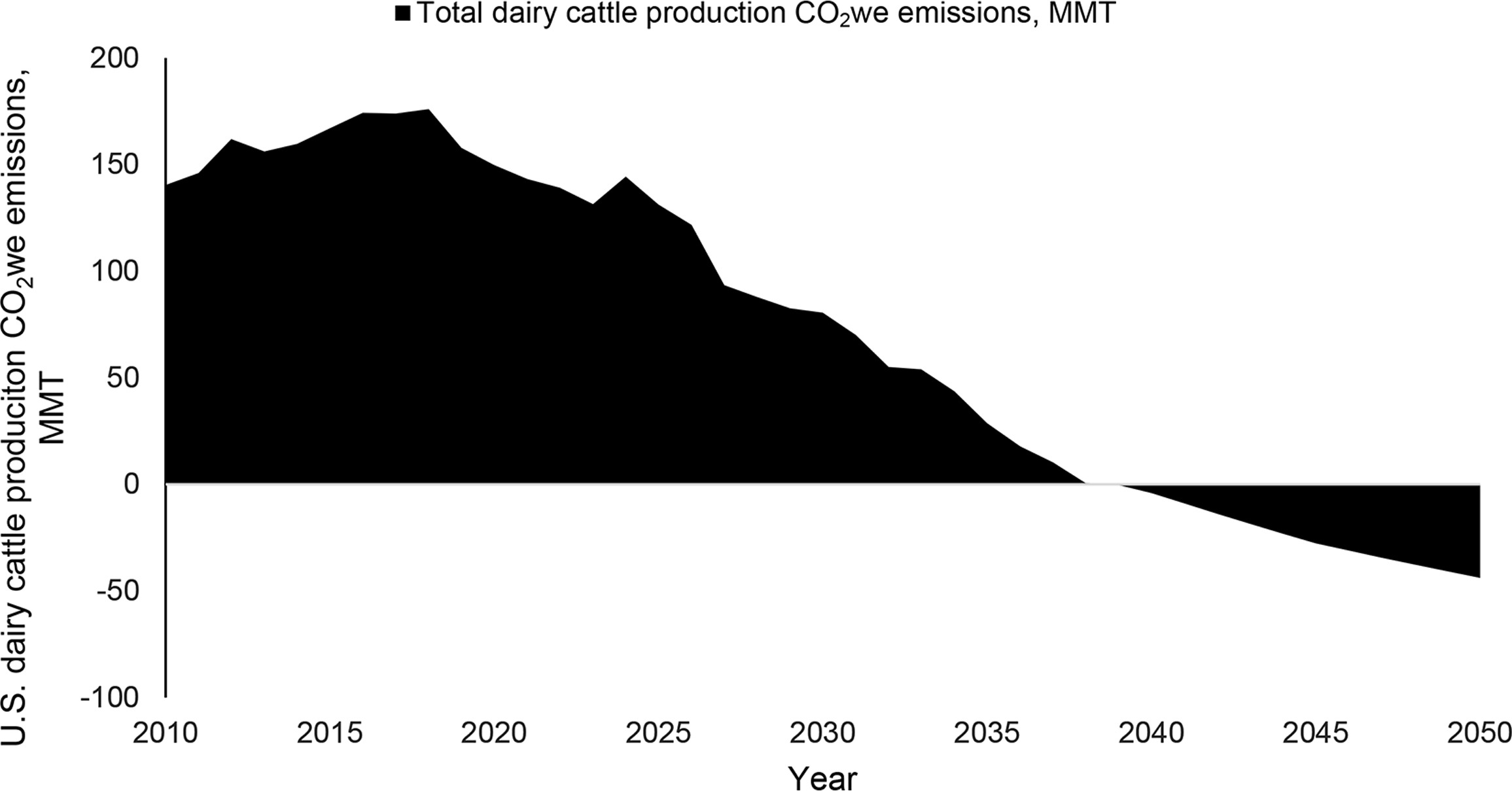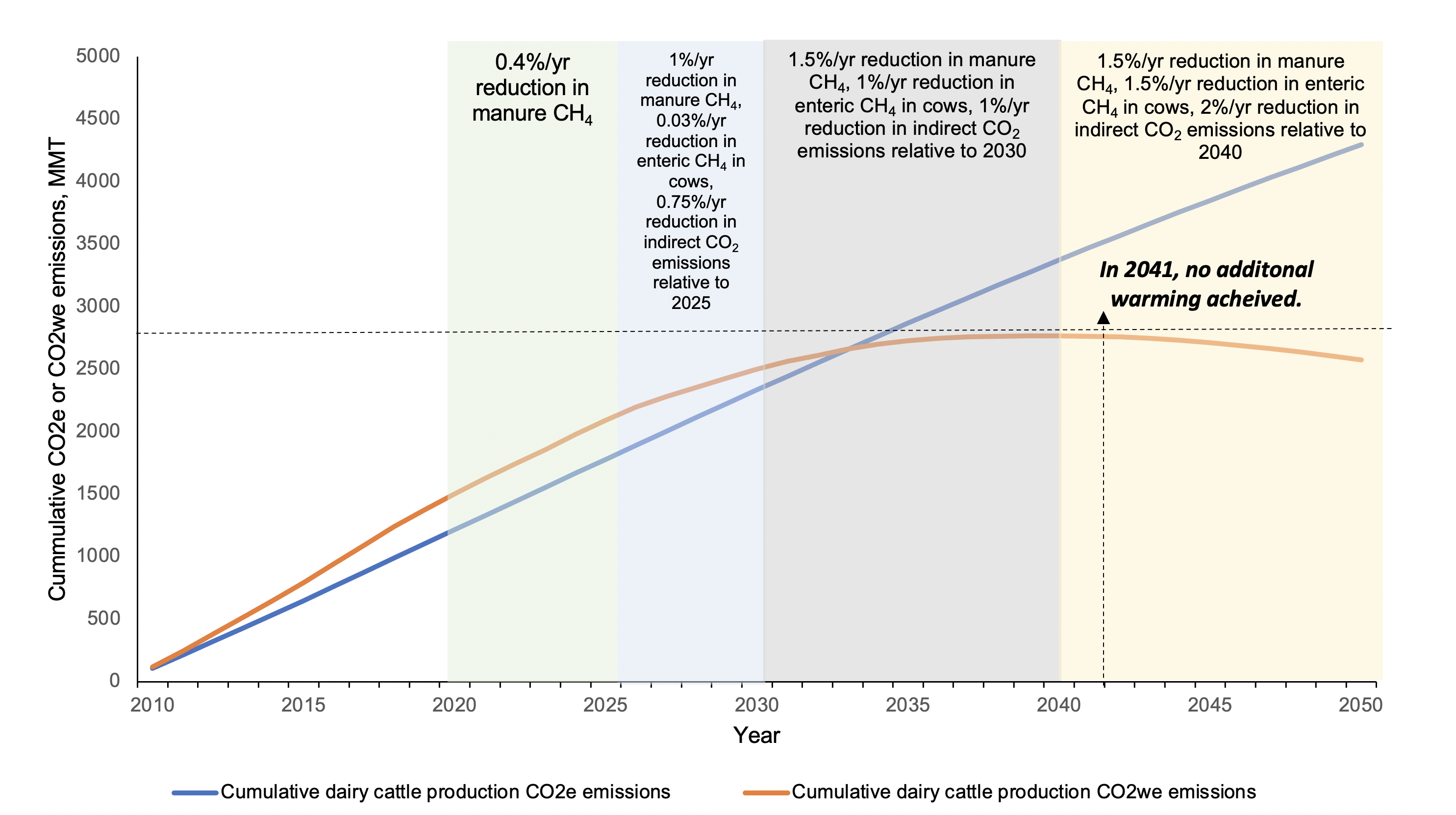
New Paper from CLEAR Center Charts Pathway to Climate Neutrality for US Dairy
By Victoria McJunkin
Quick facts:
- U.S. cattle sectors should aim for climate neutrality when setting climate goals.
- It is essential to quantify greenhouse gas emissions by how they impact temperature over time — GWP* allows us to do so.
- By making relatively small reductions year by year, the U.S. dairy industry could reach climate neutrality by the year 2041, according to a case study in the published paper.
Read the paper here
A new study from the CLEAR Center at the University of California, Davis and Elanco Animal Health outlines a path for the U.S. dairy industry to reach climate neutrality as soon as 2041. The study, published in the Journal of Dairy Science, leverages sustainable measures and innovations the US dairy industry has already been employing to battle climate change. The paper was written by Dr. Frank Mitloehner, Conor McCabe and Dr. Sara E. Place.
The study calls for the U.S. dairy industry to aim for climate neutrality rather than net-zero carbon. Net zero carbon refers to a state where carbon is removed from the atmosphere (through carbon sinks or other offsets) at a rate equal to carbon being emitted into the atmosphere. This balance between carbon emission and removal creates a “net-zero” carbon output. Climate neutrality, on the other hand, focuses on temperature impacts from emission sources, referring to the point in which no additional warming is added to the atmosphere. While climate neutrality is analogous to net-zero carbon when dealing with long-lived greenhouse gasses such as carbon dioxide, short-lived pollutants like methane do not need to reach net-zero carbon to be climate neutral.
“Because methane breaks down in the atmosphere after about 12 years, methane is being destroyed in the atmosphere while it is also being emitted. As such, if methane emissions are stable for 12 years, what is emitted will nearly balance out with what is removed, and thus impacts on warming will be stable since concentrations of methane will not be increasing,” said Mitloehner. “Climate neutrality is a feasible goal for U.S. dairy, as methane is the main greenhouse gas associated with them. With continued emphasis on methane reductions, climate neutrality – and even beyond neutrality – is within reach for U.S. dairy the near future.”
| Term | Definition |
|---|---|
| Carbon Neutral | The IPCC (2021) defines carbon neutral as the condition in which anthropogenic CO2 emissions associated with a subject are balanced by anthropogenic CO2 removals. The subject can be an entity such as a country, an organization, a district or a commodity, or an activity such as a service and an event. Carbon neutrality is often assessed over the life cycle including indirect (i.e., “scope 3”) emissions, but can also be limited to the emissions and removals, over a specified period, for which the subject has direct control, as determined by the relevant scheme. |
| Net Zero CO2 Emissions | Net zero CO2 emissions are defined by the IPCC (2021) as the condition in which anthropogenic carbon dioxide (CO2) emissions are balanced by anthropogenic CO2 removals over a specified period. At a global scale, the terms carbon neutrality and net zero CO2 emissions are equivalent. At subglobal scales, net zero CO2 emissions is generally applied to emissions and removals under direct control or territorial responsibility of the reporting entity, whereas carbon neutrality generally includes emissions and removals within and beyond the direct control or territorial responsibility of the reporting entity (e.g., life cycle emissions). |
| Net Zero GHG Emissions | Net zero greenhouse gas (GHG) emissions are defined as by the IPCC (2021) as the condition in which metric-weighted anthropogenic GHG emissions associated with a subject are balanced by metric-weighted anthropogenic GHG removals. The subject can be an entity such as a country, an organization, a district or a commodity, or an activity such as a service and an event. GHG neutrality is often assessed over the life cycle including indirect (i.e., “scope 3”) emissions, but can also be limited to the emissions and removals, over a specified period, for which the subject has direct control, as determined by the relevant scheme. The quantification of GHG emissions and removals depends on the GHG emission metric chosen to compare emissions and removals of different gases, as well as the time horizon chosen for that metric. |
| Net Zero Warming | Net zero warming is not formally defined by the IPCC; however, it has been described by Cain et al. (2019) as net zero (emissions plus removals) CO2 warming equivalent emissions as calculated using GWP* for short-lived climate pollutants such as CH4. Net zero warming implies activities from an entity at the regional, subnational, or national scale would not lead to additional warming, and could be defined by reaching and maintaining net zero CO2 warming equivalent emissions. |
| Climate Neutrality | Climate neutrality is not formally defined by the IPCC; however, in common usage it can be viewed as equivalent to achieving no additional climate impact from activities from an entity at the regional, subnational, or national scale (Pineda and Faria, 2019). Climate neutrality can be viewed as equivalent to net zero warming and can be characterized by achieving and maintaining net emissions at zero CO2 warming equivalents. |
Aiming for net-zero carbon is necessary to stop further climate warming by sectors primarily emitting carbon dioxide. However, sectors in which methane is the main greenhouse gas emitted need to reduce methane below baseline levels to reach a point at which they are no longer adding to warming. Such is the case for the U.S. dairy industry, where methane makes up 62% of its greenhouse gas emissions. Given the cattle sector’s large proportion of methane emissions, U.S. dairies can most effectively combat climate change by concentrating their efforts on climate neutrality and then continuing beyond to reduce historical warming.
Working toward climate neutrality also aligns with the goals specified by the Paris Agreement, an international treaty on climate change that aims to limit global warming to below 2 degrees Celsius. Unlike other climate agreements that outline their goals in terms of greenhouse gas emissions targets, the Paris Agreement focuses on measures that limit temperature change.
Thus, it is essential to quantify greenhouse gas emissions by how they impact temperature over time. However, when it comes to measuring greenhouse gas reductions, there are conflicting metrics that exist for the US dairy industry.
"The U.S. dairy industry has set an ambitious goal for achieving greenhouse gas neutrality by 2050; however, if the goal is meant to align with the Paris Climate Agreement, it's important to use metrics that are fit-for-purpose to connect emissions reductions to temperature responses," said Dr. Place.
The warming potential for greenhouse gasses is typically expressed as a metric called Global Warming Potential 100, or GWP100, which quantifies the warming potential of a gas over the course of 100 years relative to carbon dioxide. While this metric is appropriate for long-lived gasses such as carbon dioxide and nitrous oxide, it fails to account for the atmospheric removal of methane.
When methane emissions are declining or even stable, GWP100 tends to overestimate its warming intensity. Conversely, when methane emissions are rising, GWP underestimates the impact of methane emissions. All these scenarios demonstrate the importance of using appropriate metrics when measuring progress toward climate goals.

Recognizing this shortfall in the long-standing GWP100 system, the CLEAR Center and Dr. Place study evaluates data collected on dairy emissions via GWP star (GWP*), a newer metric developed at the University of Oxford.
“GWP* allows us to measure how greenhouse gas emissions are impacting temperature, not just how they compare to carbon dioxide,” said McCabe, a third-year doctoral student in Mitloehner’s lab. “If we’re concerned about warming, then we should be using a metric that measures warming when appropriate.”
GWP* serves as a fit-for-purpose metric to quantify the global temperature impacts of greenhouse gases and allows for agricultural sectors to plan for effective change. Thus, the study takes existing data and converts it according to GWP* to estimate the emissions reductions necessary for U.S. dairies to reach climate neutrality by 2050.
By making achievable reductions per year, the industry could potentially reach climate neutrality by the year 2041, according to a case study in the published paper. However, the path to climate neutrality is dependent on using accurate metric analysis and continued hard work to reduce overall methane emissions. Methane’s short lifespan and strong warming impact still demands immediate attention even after it is measured correctly. Case in point, GWP* shows that increases in methane emissions from the U.S. dairy sector over the past two decades has been underestimated by GWP100.

Fortunately, there is an abundance of innovative technology designed to tackle just that. Methane emitted from belching cows is being mitigated by new feed additives, which maximize an animal’s energy consumption and limit greenhouse gas emissions. Manure from livestock is another pain point for greenhouse gas emissions, but a host of new manure management techniques are combatting this. Anaerobic biogas digesters are one such strategy, along with alternative manure management plans such as composting, acidification and vermifiltration. By implementing strategies such as these, the U.S. dairy industry could reduce greenhouse gas emissions by an estimated 23% by 2050.

Although climate neutrality in the U.S. dairy sector is not the be-all and end-all to the problem of global warming, it is nevertheless an important endeavor. By using appropriate metrics such as GWP* to measure reductions, and by utilizing and incentivizing innovations to reduce greenhouse gas emissions, the industry is well on track to achieve climate neutrality by 2041.
To read the paper, visit the Journal of Dairy Science.
Media Resources
Joe Proudman at jproudman@ucdavis.edu
